Case Study: Nursing Assessments for Post-Operative Appendectomy Care
VerifiedAdded on 2023/01/12
|7
|2063
|48
Case Study
AI Summary
This case study analyzes the post-operative care of Mr. Oliver Thompson, who underwent an emergency appendectomy for a ruptured appendix. The assignment details the nursing assessments required immediately after surgery, including rationale for each assessment, considering the patient's condition and the need for continuous monitoring. It explores the nursing assessments needed for a patient on IV therapy, including the rationale behind the therapy, the type of fluid administered (Normal Saline), and the importance of monitoring for complications. The case study further emphasizes the importance of patient handover using the ISOBAR framework, outlining the essential elements for effective communication between nurses during shift changes. The case study also provides an overview of the patient's symptoms, causes of the condition, and the importance of proper diagnosis and treatment. The report concludes with a summary of the key findings and the significance of nursing care in ensuring positive patient outcomes.

Case Study
Paraphrase This Document
Need a fresh take? Get an instant paraphrase of this document with our AI Paraphraser
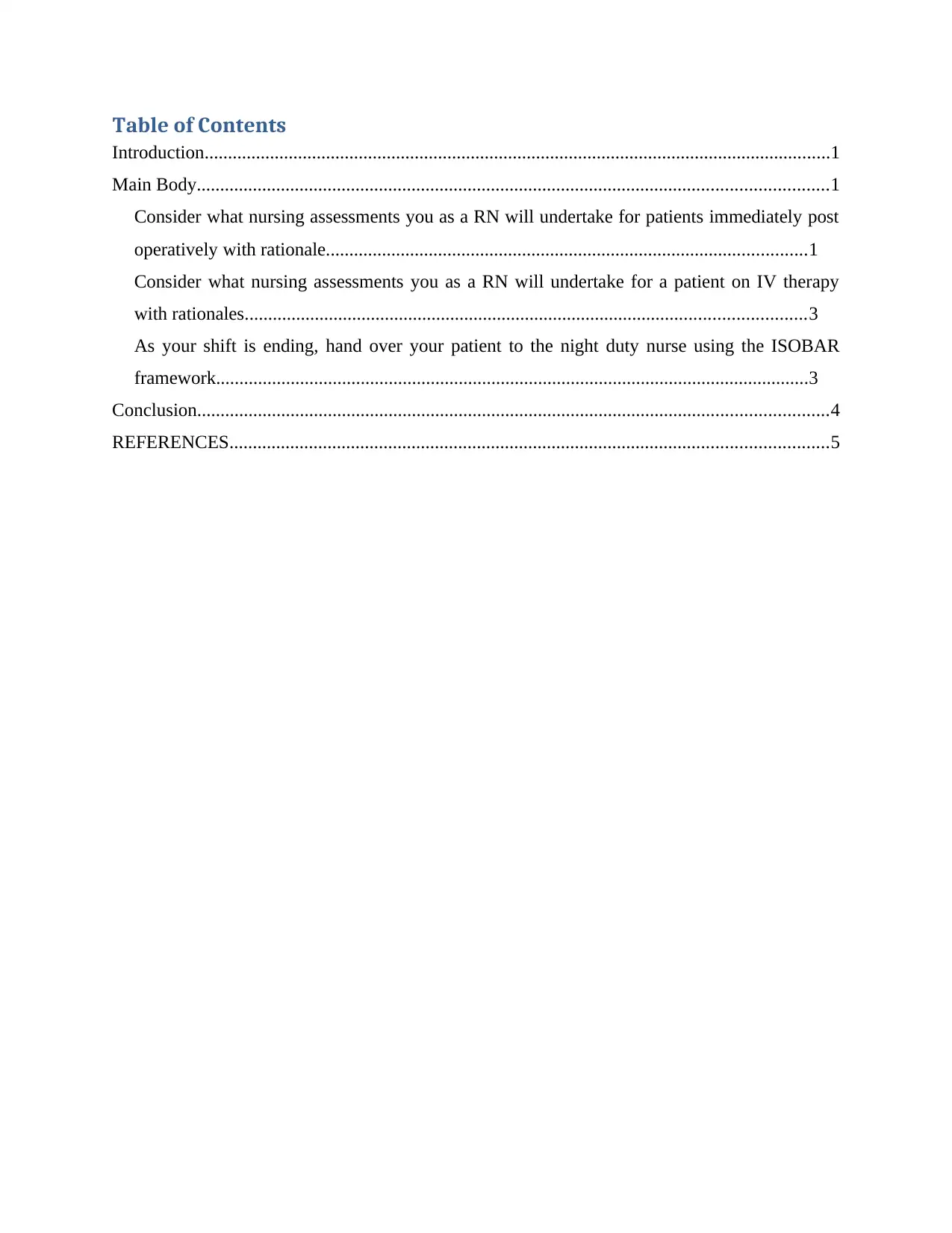
Table of Contents
Introduction......................................................................................................................................1
Main Body.......................................................................................................................................1
Consider what nursing assessments you as a RN will undertake for patients immediately post
operatively with rationale.......................................................................................................1
Consider what nursing assessments you as a RN will undertake for a patient on IV therapy
with rationales........................................................................................................................3
As your shift is ending, hand over your patient to the night duty nurse using the ISOBAR
framework...............................................................................................................................3
Conclusion.......................................................................................................................................4
REFERENCES................................................................................................................................5
Introduction......................................................................................................................................1
Main Body.......................................................................................................................................1
Consider what nursing assessments you as a RN will undertake for patients immediately post
operatively with rationale.......................................................................................................1
Consider what nursing assessments you as a RN will undertake for a patient on IV therapy
with rationales........................................................................................................................3
As your shift is ending, hand over your patient to the night duty nurse using the ISOBAR
framework...............................................................................................................................3
Conclusion.......................................................................................................................................4
REFERENCES................................................................................................................................5
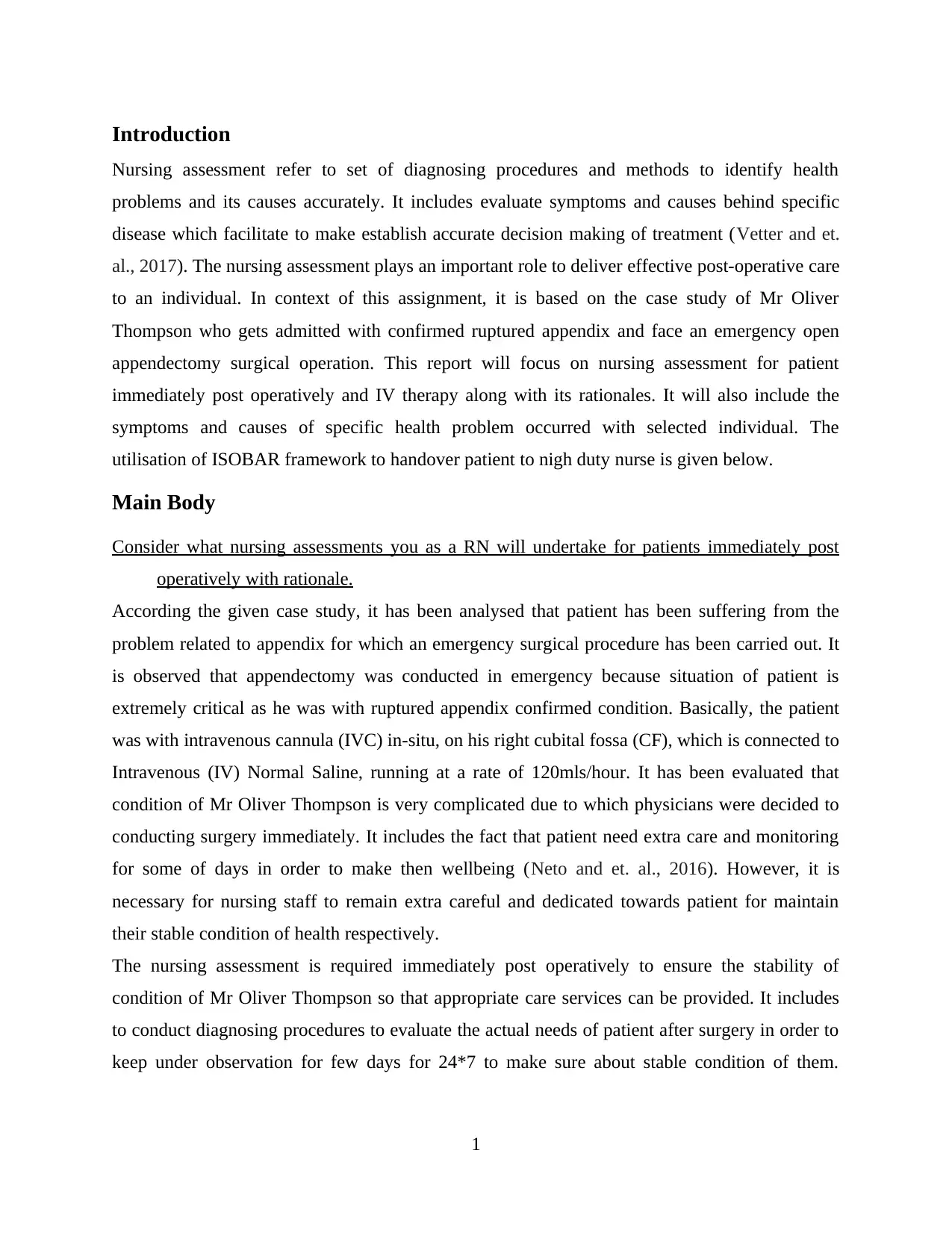
Introduction
Nursing assessment refer to set of diagnosing procedures and methods to identify health
problems and its causes accurately. It includes evaluate symptoms and causes behind specific
disease which facilitate to make establish accurate decision making of treatment (Vetter and et.
al., 2017). The nursing assessment plays an important role to deliver effective post-operative care
to an individual. In context of this assignment, it is based on the case study of Mr Oliver
Thompson who gets admitted with confirmed ruptured appendix and face an emergency open
appendectomy surgical operation. This report will focus on nursing assessment for patient
immediately post operatively and IV therapy along with its rationales. It will also include the
symptoms and causes of specific health problem occurred with selected individual. The
utilisation of ISOBAR framework to handover patient to nigh duty nurse is given below.
Main Body
Consider what nursing assessments you as a RN will undertake for patients immediately post
operatively with rationale.
According the given case study, it has been analysed that patient has been suffering from the
problem related to appendix for which an emergency surgical procedure has been carried out. It
is observed that appendectomy was conducted in emergency because situation of patient is
extremely critical as he was with ruptured appendix confirmed condition. Basically, the patient
was with intravenous cannula (IVC) in-situ, on his right cubital fossa (CF), which is connected to
Intravenous (IV) Normal Saline, running at a rate of 120mls/hour. It has been evaluated that
condition of Mr Oliver Thompson is very complicated due to which physicians were decided to
conducting surgery immediately. It includes the fact that patient need extra care and monitoring
for some of days in order to make then wellbeing (Neto and et. al., 2016). However, it is
necessary for nursing staff to remain extra careful and dedicated towards patient for maintain
their stable condition of health respectively.
The nursing assessment is required immediately post operatively to ensure the stability of
condition of Mr Oliver Thompson so that appropriate care services can be provided. It includes
to conduct diagnosing procedures to evaluate the actual needs of patient after surgery in order to
keep under observation for few days for 24*7 to make sure about stable condition of them.
1
Nursing assessment refer to set of diagnosing procedures and methods to identify health
problems and its causes accurately. It includes evaluate symptoms and causes behind specific
disease which facilitate to make establish accurate decision making of treatment (Vetter and et.
al., 2017). The nursing assessment plays an important role to deliver effective post-operative care
to an individual. In context of this assignment, it is based on the case study of Mr Oliver
Thompson who gets admitted with confirmed ruptured appendix and face an emergency open
appendectomy surgical operation. This report will focus on nursing assessment for patient
immediately post operatively and IV therapy along with its rationales. It will also include the
symptoms and causes of specific health problem occurred with selected individual. The
utilisation of ISOBAR framework to handover patient to nigh duty nurse is given below.
Main Body
Consider what nursing assessments you as a RN will undertake for patients immediately post
operatively with rationale.
According the given case study, it has been analysed that patient has been suffering from the
problem related to appendix for which an emergency surgical procedure has been carried out. It
is observed that appendectomy was conducted in emergency because situation of patient is
extremely critical as he was with ruptured appendix confirmed condition. Basically, the patient
was with intravenous cannula (IVC) in-situ, on his right cubital fossa (CF), which is connected to
Intravenous (IV) Normal Saline, running at a rate of 120mls/hour. It has been evaluated that
condition of Mr Oliver Thompson is very complicated due to which physicians were decided to
conducting surgery immediately. It includes the fact that patient need extra care and monitoring
for some of days in order to make then wellbeing (Neto and et. al., 2016). However, it is
necessary for nursing staff to remain extra careful and dedicated towards patient for maintain
their stable condition of health respectively.
The nursing assessment is required immediately post operatively to ensure the stability of
condition of Mr Oliver Thompson so that appropriate care services can be provided. It includes
to conduct diagnosing procedures to evaluate the actual needs of patient after surgery in order to
keep under observation for few days for 24*7 to make sure about stable condition of them.
1
⊘ This is a preview!⊘
Do you want full access?
Subscribe today to unlock all pages.

Trusted by 1+ million students worldwide
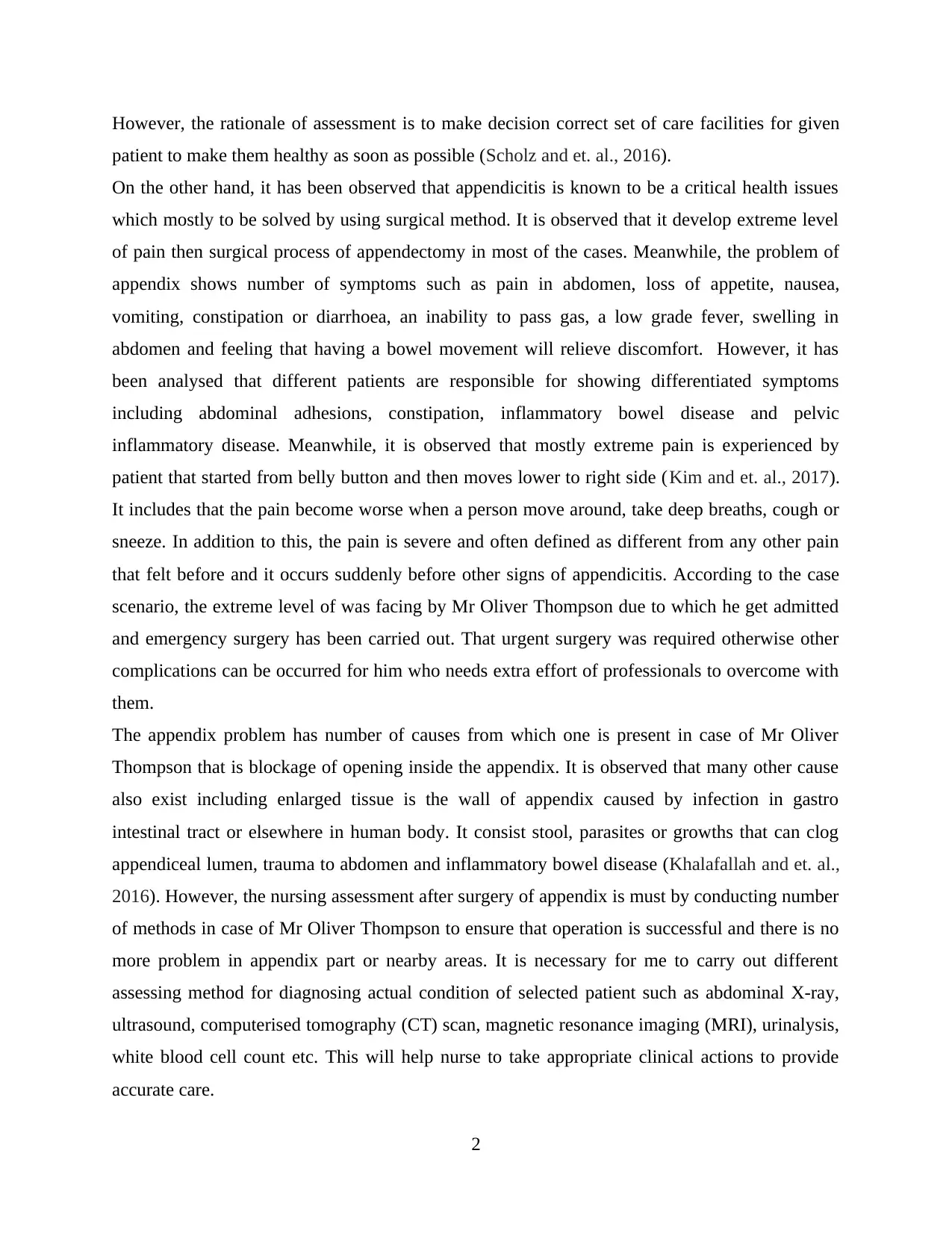
However, the rationale of assessment is to make decision correct set of care facilities for given
patient to make them healthy as soon as possible (Scholz and et. al., 2016).
On the other hand, it has been observed that appendicitis is known to be a critical health issues
which mostly to be solved by using surgical method. It is observed that it develop extreme level
of pain then surgical process of appendectomy in most of the cases. Meanwhile, the problem of
appendix shows number of symptoms such as pain in abdomen, loss of appetite, nausea,
vomiting, constipation or diarrhoea, an inability to pass gas, a low grade fever, swelling in
abdomen and feeling that having a bowel movement will relieve discomfort. However, it has
been analysed that different patients are responsible for showing differentiated symptoms
including abdominal adhesions, constipation, inflammatory bowel disease and pelvic
inflammatory disease. Meanwhile, it is observed that mostly extreme pain is experienced by
patient that started from belly button and then moves lower to right side (Kim and et. al., 2017).
It includes that the pain become worse when a person move around, take deep breaths, cough or
sneeze. In addition to this, the pain is severe and often defined as different from any other pain
that felt before and it occurs suddenly before other signs of appendicitis. According to the case
scenario, the extreme level of was facing by Mr Oliver Thompson due to which he get admitted
and emergency surgery has been carried out. That urgent surgery was required otherwise other
complications can be occurred for him who needs extra effort of professionals to overcome with
them.
The appendix problem has number of causes from which one is present in case of Mr Oliver
Thompson that is blockage of opening inside the appendix. It is observed that many other cause
also exist including enlarged tissue is the wall of appendix caused by infection in gastro
intestinal tract or elsewhere in human body. It consist stool, parasites or growths that can clog
appendiceal lumen, trauma to abdomen and inflammatory bowel disease (Khalafallah and et. al.,
2016). However, the nursing assessment after surgery of appendix is must by conducting number
of methods in case of Mr Oliver Thompson to ensure that operation is successful and there is no
more problem in appendix part or nearby areas. It is necessary for me to carry out different
assessing method for diagnosing actual condition of selected patient such as abdominal X-ray,
ultrasound, computerised tomography (CT) scan, magnetic resonance imaging (MRI), urinalysis,
white blood cell count etc. This will help nurse to take appropriate clinical actions to provide
accurate care.
2
patient to make them healthy as soon as possible (Scholz and et. al., 2016).
On the other hand, it has been observed that appendicitis is known to be a critical health issues
which mostly to be solved by using surgical method. It is observed that it develop extreme level
of pain then surgical process of appendectomy in most of the cases. Meanwhile, the problem of
appendix shows number of symptoms such as pain in abdomen, loss of appetite, nausea,
vomiting, constipation or diarrhoea, an inability to pass gas, a low grade fever, swelling in
abdomen and feeling that having a bowel movement will relieve discomfort. However, it has
been analysed that different patients are responsible for showing differentiated symptoms
including abdominal adhesions, constipation, inflammatory bowel disease and pelvic
inflammatory disease. Meanwhile, it is observed that mostly extreme pain is experienced by
patient that started from belly button and then moves lower to right side (Kim and et. al., 2017).
It includes that the pain become worse when a person move around, take deep breaths, cough or
sneeze. In addition to this, the pain is severe and often defined as different from any other pain
that felt before and it occurs suddenly before other signs of appendicitis. According to the case
scenario, the extreme level of was facing by Mr Oliver Thompson due to which he get admitted
and emergency surgery has been carried out. That urgent surgery was required otherwise other
complications can be occurred for him who needs extra effort of professionals to overcome with
them.
The appendix problem has number of causes from which one is present in case of Mr Oliver
Thompson that is blockage of opening inside the appendix. It is observed that many other cause
also exist including enlarged tissue is the wall of appendix caused by infection in gastro
intestinal tract or elsewhere in human body. It consist stool, parasites or growths that can clog
appendiceal lumen, trauma to abdomen and inflammatory bowel disease (Khalafallah and et. al.,
2016). However, the nursing assessment after surgery of appendix is must by conducting number
of methods in case of Mr Oliver Thompson to ensure that operation is successful and there is no
more problem in appendix part or nearby areas. It is necessary for me to carry out different
assessing method for diagnosing actual condition of selected patient such as abdominal X-ray,
ultrasound, computerised tomography (CT) scan, magnetic resonance imaging (MRI), urinalysis,
white blood cell count etc. This will help nurse to take appropriate clinical actions to provide
accurate care.
2
Paraphrase This Document
Need a fresh take? Get an instant paraphrase of this document with our AI Paraphraser
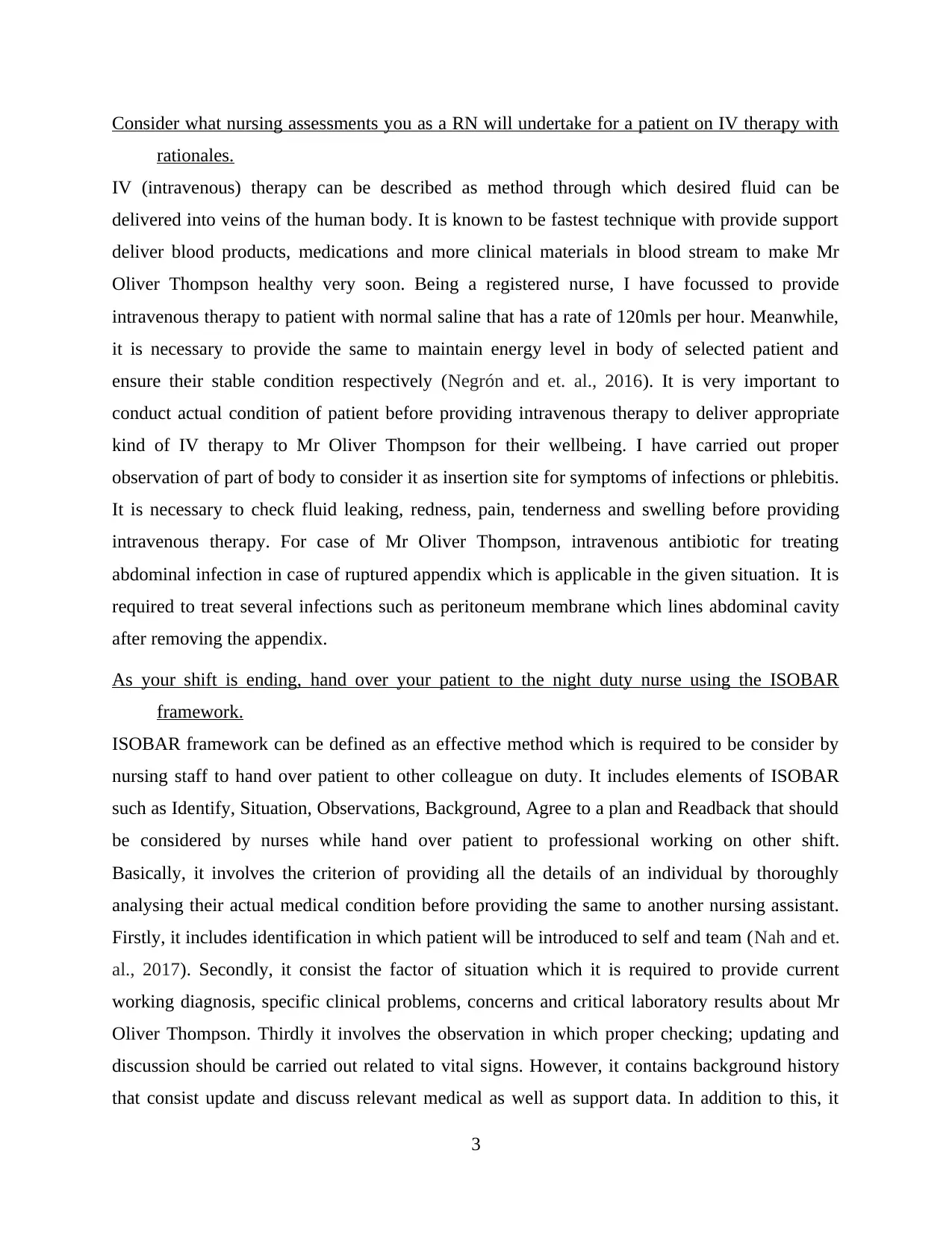
Consider what nursing assessments you as a RN will undertake for a patient on IV therapy with
rationales.
IV (intravenous) therapy can be described as method through which desired fluid can be
delivered into veins of the human body. It is known to be fastest technique with provide support
deliver blood products, medications and more clinical materials in blood stream to make Mr
Oliver Thompson healthy very soon. Being a registered nurse, I have focussed to provide
intravenous therapy to patient with normal saline that has a rate of 120mls per hour. Meanwhile,
it is necessary to provide the same to maintain energy level in body of selected patient and
ensure their stable condition respectively (Negrón and et. al., 2016). It is very important to
conduct actual condition of patient before providing intravenous therapy to deliver appropriate
kind of IV therapy to Mr Oliver Thompson for their wellbeing. I have carried out proper
observation of part of body to consider it as insertion site for symptoms of infections or phlebitis.
It is necessary to check fluid leaking, redness, pain, tenderness and swelling before providing
intravenous therapy. For case of Mr Oliver Thompson, intravenous antibiotic for treating
abdominal infection in case of ruptured appendix which is applicable in the given situation. It is
required to treat several infections such as peritoneum membrane which lines abdominal cavity
after removing the appendix.
As your shift is ending, hand over your patient to the night duty nurse using the ISOBAR
framework.
ISOBAR framework can be defined as an effective method which is required to be consider by
nursing staff to hand over patient to other colleague on duty. It includes elements of ISOBAR
such as Identify, Situation, Observations, Background, Agree to a plan and Readback that should
be considered by nurses while hand over patient to professional working on other shift.
Basically, it involves the criterion of providing all the details of an individual by thoroughly
analysing their actual medical condition before providing the same to another nursing assistant.
Firstly, it includes identification in which patient will be introduced to self and team (Nah and et.
al., 2017). Secondly, it consist the factor of situation which it is required to provide current
working diagnosis, specific clinical problems, concerns and critical laboratory results about Mr
Oliver Thompson. Thirdly it involves the observation in which proper checking; updating and
discussion should be carried out related to vital signs. However, it contains background history
that consist update and discuss relevant medical as well as support data. In addition to this, it
3
rationales.
IV (intravenous) therapy can be described as method through which desired fluid can be
delivered into veins of the human body. It is known to be fastest technique with provide support
deliver blood products, medications and more clinical materials in blood stream to make Mr
Oliver Thompson healthy very soon. Being a registered nurse, I have focussed to provide
intravenous therapy to patient with normal saline that has a rate of 120mls per hour. Meanwhile,
it is necessary to provide the same to maintain energy level in body of selected patient and
ensure their stable condition respectively (Negrón and et. al., 2016). It is very important to
conduct actual condition of patient before providing intravenous therapy to deliver appropriate
kind of IV therapy to Mr Oliver Thompson for their wellbeing. I have carried out proper
observation of part of body to consider it as insertion site for symptoms of infections or phlebitis.
It is necessary to check fluid leaking, redness, pain, tenderness and swelling before providing
intravenous therapy. For case of Mr Oliver Thompson, intravenous antibiotic for treating
abdominal infection in case of ruptured appendix which is applicable in the given situation. It is
required to treat several infections such as peritoneum membrane which lines abdominal cavity
after removing the appendix.
As your shift is ending, hand over your patient to the night duty nurse using the ISOBAR
framework.
ISOBAR framework can be defined as an effective method which is required to be consider by
nursing staff to hand over patient to other colleague on duty. It includes elements of ISOBAR
such as Identify, Situation, Observations, Background, Agree to a plan and Readback that should
be considered by nurses while hand over patient to professional working on other shift.
Basically, it involves the criterion of providing all the details of an individual by thoroughly
analysing their actual medical condition before providing the same to another nursing assistant.
Firstly, it includes identification in which patient will be introduced to self and team (Nah and et.
al., 2017). Secondly, it consist the factor of situation which it is required to provide current
working diagnosis, specific clinical problems, concerns and critical laboratory results about Mr
Oliver Thompson. Thirdly it involves the observation in which proper checking; updating and
discussion should be carried out related to vital signs. However, it contains background history
that consist update and discuss relevant medical as well as support data. In addition to this, it
3
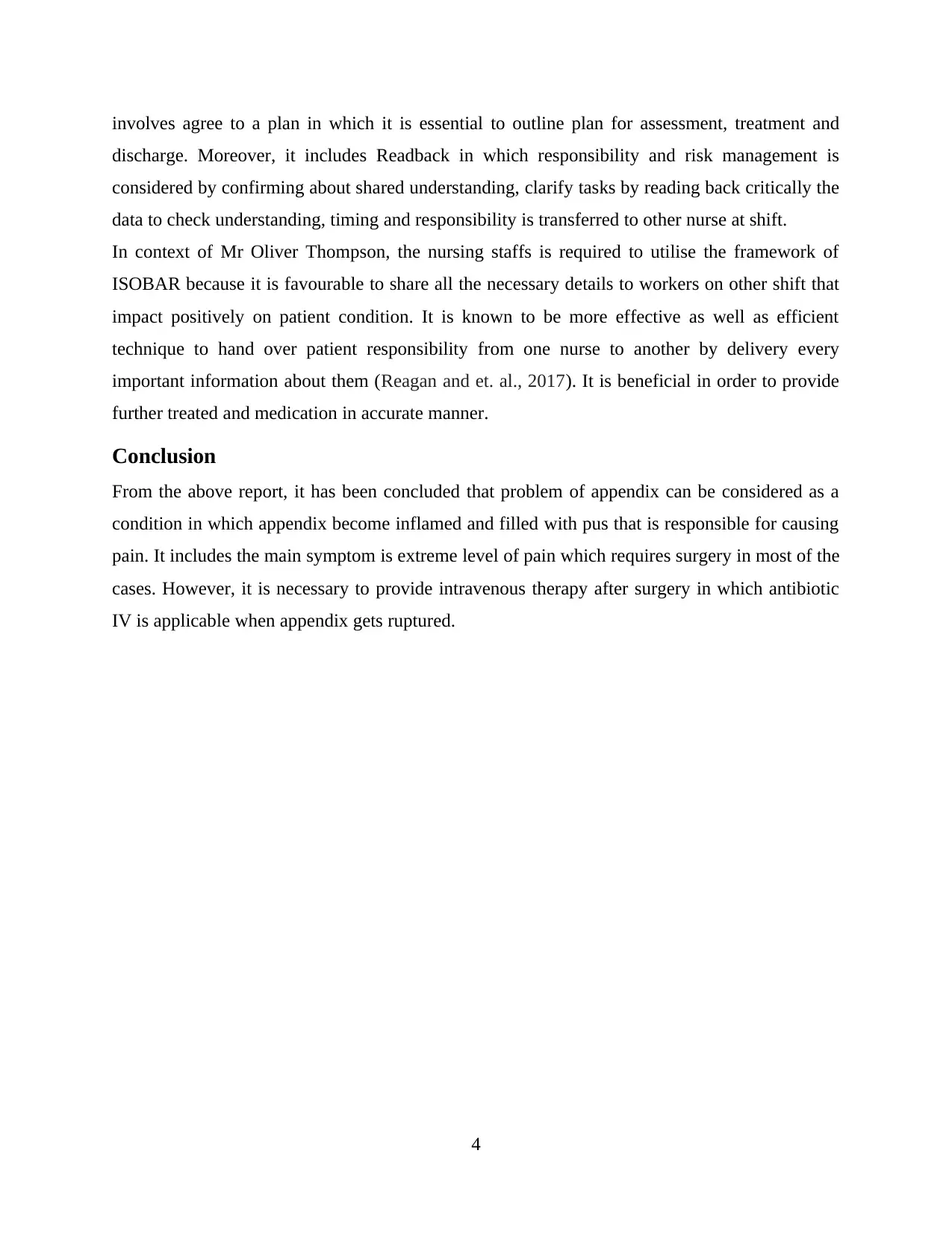
involves agree to a plan in which it is essential to outline plan for assessment, treatment and
discharge. Moreover, it includes Readback in which responsibility and risk management is
considered by confirming about shared understanding, clarify tasks by reading back critically the
data to check understanding, timing and responsibility is transferred to other nurse at shift.
In context of Mr Oliver Thompson, the nursing staffs is required to utilise the framework of
ISOBAR because it is favourable to share all the necessary details to workers on other shift that
impact positively on patient condition. It is known to be more effective as well as efficient
technique to hand over patient responsibility from one nurse to another by delivery every
important information about them (Reagan and et. al., 2017). It is beneficial in order to provide
further treated and medication in accurate manner.
Conclusion
From the above report, it has been concluded that problem of appendix can be considered as a
condition in which appendix become inflamed and filled with pus that is responsible for causing
pain. It includes the main symptom is extreme level of pain which requires surgery in most of the
cases. However, it is necessary to provide intravenous therapy after surgery in which antibiotic
IV is applicable when appendix gets ruptured.
4
discharge. Moreover, it includes Readback in which responsibility and risk management is
considered by confirming about shared understanding, clarify tasks by reading back critically the
data to check understanding, timing and responsibility is transferred to other nurse at shift.
In context of Mr Oliver Thompson, the nursing staffs is required to utilise the framework of
ISOBAR because it is favourable to share all the necessary details to workers on other shift that
impact positively on patient condition. It is known to be more effective as well as efficient
technique to hand over patient responsibility from one nurse to another by delivery every
important information about them (Reagan and et. al., 2017). It is beneficial in order to provide
further treated and medication in accurate manner.
Conclusion
From the above report, it has been concluded that problem of appendix can be considered as a
condition in which appendix become inflamed and filled with pus that is responsible for causing
pain. It includes the main symptom is extreme level of pain which requires surgery in most of the
cases. However, it is necessary to provide intravenous therapy after surgery in which antibiotic
IV is applicable when appendix gets ruptured.
4
⊘ This is a preview!⊘
Do you want full access?
Subscribe today to unlock all pages.

Trusted by 1+ million students worldwide
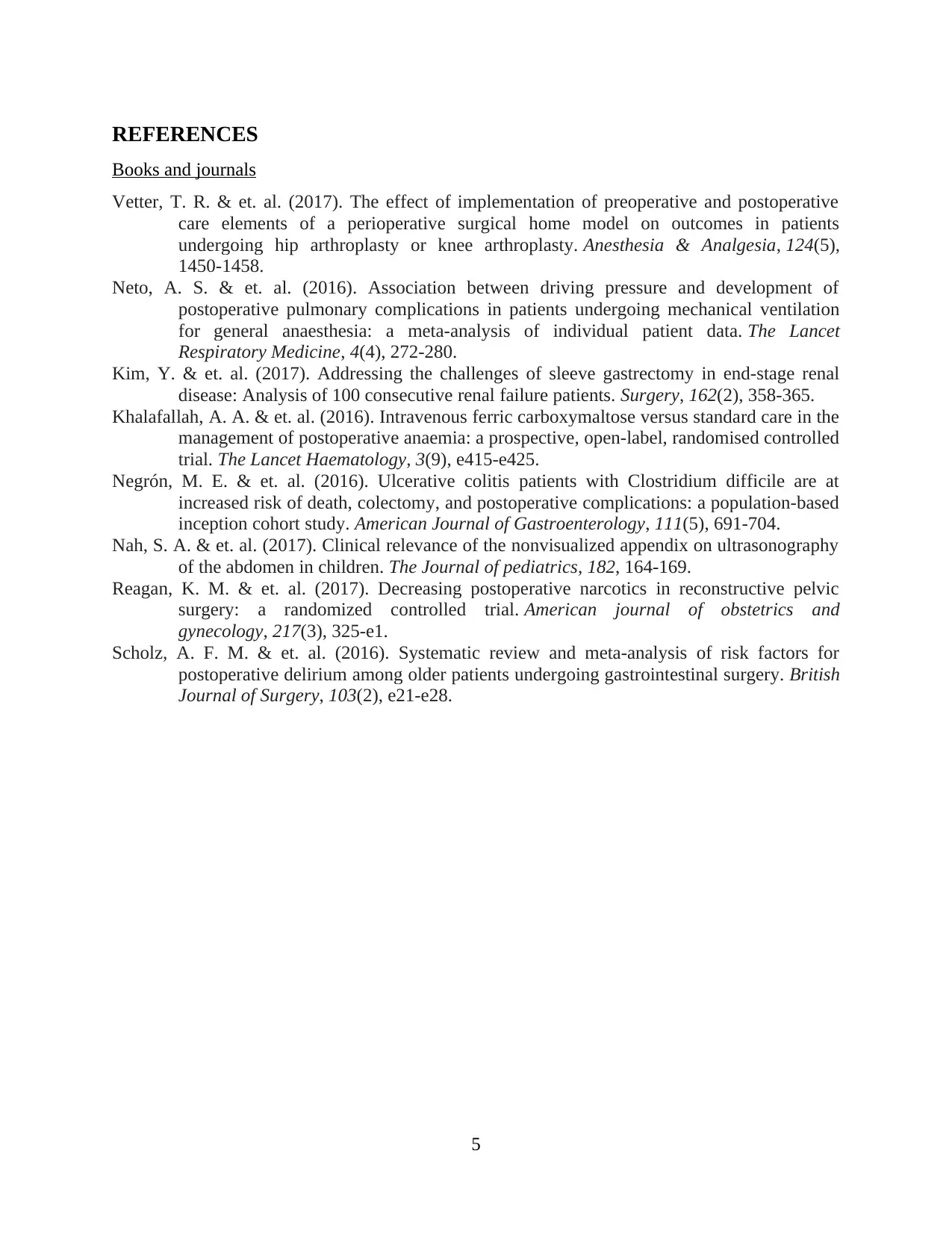
REFERENCES
Books and journals
Vetter, T. R. & et. al. (2017). The effect of implementation of preoperative and postoperative
care elements of a perioperative surgical home model on outcomes in patients
undergoing hip arthroplasty or knee arthroplasty. Anesthesia & Analgesia, 124(5),
1450-1458.
Neto, A. S. & et. al. (2016). Association between driving pressure and development of
postoperative pulmonary complications in patients undergoing mechanical ventilation
for general anaesthesia: a meta-analysis of individual patient data. The Lancet
Respiratory Medicine, 4(4), 272-280.
Kim, Y. & et. al. (2017). Addressing the challenges of sleeve gastrectomy in end-stage renal
disease: Analysis of 100 consecutive renal failure patients. Surgery, 162(2), 358-365.
Khalafallah, A. A. & et. al. (2016). Intravenous ferric carboxymaltose versus standard care in the
management of postoperative anaemia: a prospective, open-label, randomised controlled
trial. The Lancet Haematology, 3(9), e415-e425.
Negrón, M. E. & et. al. (2016). Ulcerative colitis patients with Clostridium difficile are at
increased risk of death, colectomy, and postoperative complications: a population-based
inception cohort study. American Journal of Gastroenterology, 111(5), 691-704.
Nah, S. A. & et. al. (2017). Clinical relevance of the nonvisualized appendix on ultrasonography
of the abdomen in children. The Journal of pediatrics, 182, 164-169.
Reagan, K. M. & et. al. (2017). Decreasing postoperative narcotics in reconstructive pelvic
surgery: a randomized controlled trial. American journal of obstetrics and
gynecology, 217(3), 325-e1.
Scholz, A. F. M. & et. al. (2016). Systematic review and meta‐analysis of risk factors for
postoperative delirium among older patients undergoing gastrointestinal surgery. British
Journal of Surgery, 103(2), e21-e28.
5
Books and journals
Vetter, T. R. & et. al. (2017). The effect of implementation of preoperative and postoperative
care elements of a perioperative surgical home model on outcomes in patients
undergoing hip arthroplasty or knee arthroplasty. Anesthesia & Analgesia, 124(5),
1450-1458.
Neto, A. S. & et. al. (2016). Association between driving pressure and development of
postoperative pulmonary complications in patients undergoing mechanical ventilation
for general anaesthesia: a meta-analysis of individual patient data. The Lancet
Respiratory Medicine, 4(4), 272-280.
Kim, Y. & et. al. (2017). Addressing the challenges of sleeve gastrectomy in end-stage renal
disease: Analysis of 100 consecutive renal failure patients. Surgery, 162(2), 358-365.
Khalafallah, A. A. & et. al. (2016). Intravenous ferric carboxymaltose versus standard care in the
management of postoperative anaemia: a prospective, open-label, randomised controlled
trial. The Lancet Haematology, 3(9), e415-e425.
Negrón, M. E. & et. al. (2016). Ulcerative colitis patients with Clostridium difficile are at
increased risk of death, colectomy, and postoperative complications: a population-based
inception cohort study. American Journal of Gastroenterology, 111(5), 691-704.
Nah, S. A. & et. al. (2017). Clinical relevance of the nonvisualized appendix on ultrasonography
of the abdomen in children. The Journal of pediatrics, 182, 164-169.
Reagan, K. M. & et. al. (2017). Decreasing postoperative narcotics in reconstructive pelvic
surgery: a randomized controlled trial. American journal of obstetrics and
gynecology, 217(3), 325-e1.
Scholz, A. F. M. & et. al. (2016). Systematic review and meta‐analysis of risk factors for
postoperative delirium among older patients undergoing gastrointestinal surgery. British
Journal of Surgery, 103(2), e21-e28.
5
1 out of 7
Related Documents
Your All-in-One AI-Powered Toolkit for Academic Success.
+13062052269
info@desklib.com
Available 24*7 on WhatsApp / Email
![[object Object]](/_next/static/media/star-bottom.7253800d.svg)
Unlock your academic potential
Copyright © 2020–2025 A2Z Services. All Rights Reserved. Developed and managed by ZUCOL.





